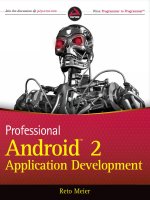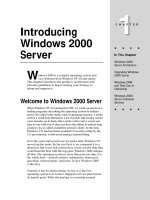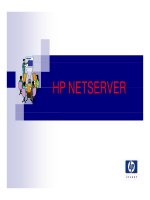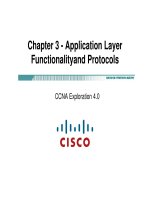Tài liệu Android Wireless Application Development doc
Bạn đang xem bản rút gọn của tài liệu. Xem và tải ngay bản đầy đủ của tài liệu tại đây (16.33 MB, 793 trang )
ptg6519196
ptg6519196
Android
™
Wireless
Application
Development
Second Edition
Wow! eBook <WoweBook.Com>
ptg6519196
This page intentionally left blank
Wow! eBook <WoweBook.Com>
ptg6519196
Android
™
Wireless
Application
Development
Second Edition
Shane Conder
Lauren Darcey
Upper Saddle River, NJ • Boston • Indianapolis • San Francisco
New York • Toronto • Montreal • London • Munich • Paris • Madrid
Cape Town • Sydney • Tokyo • Singapore • Mexico City
Wow! eBook <WoweBook.Com>
ptg6519196
Many of the designations used by manufacturers and sellers to distinguish their products
are claimed as trademarks. Where those designations appear in this book, and the publish-
er was aware of a trademark claim, the designations have been printed with initial capital
letters or in all capitals.
The authors and publisher have taken care in the preparation of this book, but make no
expressed or implied warranty of any kind and assume no responsibility for errors or omis-
sions. No liability is assumed for incidental or consequential damages in connection with or
arising out of the use of the information or programs contained herein.
The publisher offers excellent discounts on this book when ordered in quantity for bulk pur-
chases or special sales, which may include electronic versions and/or custom covers and
content particular to your business, training goals, marketing focus, and branding interests.
For more information, please contact:
U.S. Corporate and Government Sales
(800) 382-3419
For sales outside the United States please contact:
International Sales
Visit us on the Web: informit.com/aw
Library of Congress Cataloging-in-Publication Data:
Conder, Shane, 1975-
Android wireless application development / Shane Conder, Lauren Darcey. — 1st ed.
p. cm.
ISBN 978-0-321-74301-5 (pbk. : alk. paper) 1. Application software—Development. 2.
Android (Electronic resource) 3. Mobile computing. I. Darcey, Lauren, 1977- II. Title.
QA76.76.A65C6637 2011
005.1—dc22
2010046618
Copyright © 2011 Shane Conder and Lauren Darcey
All rights reserved. Printed in the United States of America. This publication is protected by
copyright, and permission must be obtained from the publisher prior to any prohibited repro-
duction, storage in a retrieval system, or transmission in any form or by any means, elec-
tronic, mechanical, photocopying, recording, or likewise. For information regarding permis-
sions, write to:
Pearson Education, Inc
Rights and Contracts Department
501 Boylston Street, Suite 900
Boston, MA 02116
Fax: (617) 671-3447
Android is the trademark of Google, Inc. Pearson Education does not assert any right to the
use of the Android trademark and neither Google nor any other third party having any claim
in the Android trademark have sponsored or are affiliated with the creation and develop-
ment of this book.
Some figures that appear in this book have been reproduced from or are modifications
based on work created and shared by the Android Open Source Project and used according
to terms described in the Creative Commons 2.5 Attribution License (http://creativecom-
mons.org/licenses/by/2.5/).
ISBN-13: 978-0-321-74301-5
ISBN-10: 0-321-74301-6
Text printed in the United States on recycled paper at Edwards Brothers, Ann Arbor,
Michigan
First printing December 2010
Editor-in-Chief
Mark Taub
Acquisitions Editor
Trina MacDonald
Development
Editor
Songlin Qiu
Managing Editor
Sandra Schroeder
Senior Project
Editor
Tonya Simpson
Copy Editor
Charlotte Kughen
Indexer
Heather McNeill
Proofreader
Water Crest
Publishing
Technical
Reviewers
Charles Stearns
Douglas Jones
Publishing
Coordinator
Olivia Basegio
Book Designer
Gary Adair
Compositor
Mark Shirar
Wow! eBook <WoweBook.Com>
ptg6519196
❖
This book is dedicated to Bit, Nibble, Stack, Queue,
Heap, and Null.
❖
Wow! eBook <WoweBook.Com>
ptg6519196
Contents at a Glance
Introduction 1
I: An Overview of Android
1 Introducing Android 7
2 Setting Up Your Android Development
Environment 29
3 Writing Your First Android Application 43
II: Android Application Design Essentials
4 Understanding the Anatomy of
an Android Application 69
5 Defining Your Application Using
the Android Manifest File 81
6 Managing Application Resources 97
III: Android User Interface Design Essentials
7 Exploring User Interface Screen Elements 133
8 Designing User Interfaces with Layouts 173
9 Drawing and Working with Animation 205
IV: Using Common Android APIs
10 Using Android Data and Storage APIs 231
11 Sharing Data Between Applications with Content
Providers 259
12 Using Android Networking APIs 287
13 Using Android Web APIs 301
14 Using Location-Based Services (LBS) APIs 315
15 Using Android Multimedia APIs 335
16 Using Android Telephony APIs 353
Wow! eBook <WoweBook.Com>
ptg6519196
17 Using Android 3D Graphics with OpenGL ES 367
18 Using the Android NDK 397
19 Using Android’s Optional Hardware APIs 407
V: More Android Application Design Principles
20 Working with Notifications 423
21 Working with Services 437
22 Extending Android Application Reach 451
23 Managing User Accounts and Synchronizing
User Data 489
24 Handling Advanced User Input 499
25 Targeting Different Device Configurations and
Languages 523
VI: Deploying Your Android Application to the World
26 The Mobile Software Development Process 551
27 Designing and Developing Bulletproof Android
Applications 571
28 Testing Android Applications 585
29 Selling Your Android Application 597
VII: Appendixes
A The Android Emulator Quick-Start Guide 613
B The Android DDMS Quick-Start Guide 635
C The Android Debug Bridge Quick-Start Guide 647
D Eclipse IDE Tips and Tricks 661
E The SQLite Quick-Start Guide 669
Index 683
Wow! eBook <WoweBook.Com>
ptg6519196
Table of Contents
Introduction 1
Who Should Read This Book 1
Key Questions Answered in This Book 2
How This Book Is Structured 2
An Overview of Changes in This Edition 3
Development Environment Used in This Book 4
Supplementary Materials Available 5
Where to Find More Information 5
Conventions Used in This Book 6
Contacting the Authors 6
I: An Overview of Android
1 Introducing Android 7
A Brief History of Mobile Software Development 7
Way Back When 7
“The Brick” 9
Wireless Application Protocol (WAP) 11
Proprietary Mobile Platforms 13
The Open Handset Alliance 15
Google Goes Wireless 15
Forming the Open Handset Alliance 15
Manufacturers: Designing the Android Handsets 16
Mobile Operators: Delivering the Android
Experience 17
Content Providers: Developing Android
Applications 17
Taking Advantage of All Android Has to Offer 18
Android Platform Differences 18
Android: A Next-Generation Platform 18
Free and Open Source 20
Familiar and Inexpensive Development Tools 20
Reasonable Learning Curve for Developers 20
Enabling Development of Powerful Applications 21
Rich, Secure Application Integration 21
No Costly Obstacles to Publication 21
Wow! eBook <WoweBook.Com>
ptg6519196
ix
Contents
A “Free Market” for Applications 22
A New and Growing Platform 22
The Android Platform 23
Android’s Underlying Architecture 23
Security and Permissions 25
Developing Android Applications 26
Summary 28
References and More Information 28
2 Setting Up Your Android Development
Environment 29
Configuring Your Development Environment 29
Configuring Your Operating System for Device
Debugging 30
Configuring Your Android Hardware for Debugging 30
Upgrading the Android SDK 31
Problems with the Android Software
Development Kit 32
Exploring the Android SDK 32
Understanding the Android SDK License
Agreement 32
Reading the Android SDK Documentation 33
Exploring the Android Application Framework 35
Getting to Know the Android Tools 35
Exploring the Android Sample Applications 40
Summary 41
References and More Information 41
3 Writing Your First Android Application 43
Testing Your Development Environment 43
Adding the Snake Application to a Project in Your
Eclipse Workspace 43
Creating an Android Virtual Device (AVD) for Your Snake
Project 44
Creating a Launch Configuration for Your
Snake Project 46
Running the Snake Application in
the Android Emulator 47
Wow! eBook <WoweBook.Com>
ptg6519196
x
Contents
Building Your First Android Application 48
Creating and Configuring a New Android Project 50
Core Files and Directories of
the Android Application 50
Creating an AVD for Your Project 51
Creating Launch Configurations for Your Project 52
Running Your Android Application in the Emulator 53
Debugging Your Android Application in
the Emulator 56
Adding Logging Support to Your Android Application 59
Adding Some Media Support to Your
Application 60
Adding Location-Based Services
to Your Application 62
Debugging Your Application on the Hardware 65
Summary 66
References and More Information 67
II: Android Application Design Essentials
4 Understanding the Anatomy of
an Android Application 69
Mastering Important Android Terminology 69
Using the Application Context 70
Retrieving the Application Context 70
Using the Application Context 70
Performing Application Tasks with Activities 71
The Lifecycle of an Android Activity 72
Managing Activity Transitions with Intents 76
Working with Services 78
Receiving and Broadcasting Intents 79
Summary 80
References and More Information 80
5 Defining Your Application Using
the Android Manifest File 81
Configuring the Android Manifest File 81
Editing the Android Manifest File 82
Wow! eBook <WoweBook.Com>
ptg6519196
xi
Contents
Managing Your Application’s Identity 86
Versioning Your Application 86
Setting the Application Name and Icon 87
Enforcing Application System Requirements 87
Targeting Specific SDK Versions 87
Enforcing Application Platform Requirements 90
Working with External Libraries 92
Registering Activities and Other Application
Components 92
Designating a Primary Entry Point Activity for Your
Application Using an Intent Filter 92
Configuring Other Intent Filters 93
Working with Permissions 94
Registering Permissions Your Application Requires 94
Registering Permissions Your Application Grants to
Other Applications 95
Exploring Other Manifest File Settings 96
Summary 96
References and More Information 96
6 Managing Application Resources 97
What Are Resources? 97
Storing Application Resources 97
Understanding the Resource Directory Hierarchy 97
Resource Value Types 99
Storing Different Resource Value Types 101
Accessing Resources Programmatically 103
Setting Simple Resource Values Using Eclipse 104
Working with Resources 107
Working with String Resources 107
Using String Resources as Format Strings 108
Working with String Arrays 109
Working with Boolean Resources 110
Working with Integer Resources 111
Working with Colors 111
Working with Dimensions 112
Working with Simple Drawables 113
Working with Images 114
Working with Animation 116
Wow! eBook <WoweBook.Com>
ptg6519196
xii
Contents
Working with Menus 119
Working with XML Files 120
Working with Raw Files 121
References to Resources 122
Working with Layouts 123
Working with Styles 127
Working with Themes 131
Referencing System Resources 131
Summary 132
References and More Information 132
III: Android User Interface Design Essentials
7 Exploring User Interface Screen Elements 133
Introducing Android Views and Layouts 133
Introducing the Android View 133
Introducing the Android Control 133
Introducing the Android Layout 134
Displaying Text to Users with TextView 134
Configuring Layout and Sizing 135
Creating Contextual Links in Text 136
Retrieving Data from Users 137
Retrieving Text Input Using EditText Controls 138
Giving Users Input Choices Using Spinner
Controls 142
Using Buttons, Check Boxes, and Radio Groups 144
Using Basic Buttons 144
Using Check Boxes and Toggle Buttons 146
Using RadioGroups and RadioButtons 147
Getting Dates and Times from Users 150
Using Indicators to Display Data to Users 151
Indicating Progress with ProgressBar 151
Adjusting Progress with SeekBar 153
Displaying Rating Data with RatingBar 154
Showing Time Passage with the Chronometer 155
Displaying the Time 156
Providing Users with Options and Context Menus 157
Enabling the Options Menu 157
Enabling the ContextMenu 159
Wow! eBook <WoweBook.Com>
ptg6519196
xiii
Contents
Handling User Events 161
Listening for Touch Mode Changes 161
Listening for Events on the Entire Screen 162
Listening for Long Clicks 163
Listening for Focus Changes 164
Working with Dialogs 165
Exploring the Different Types of Dialogs 165
Tracing the Lifecycle of a Dialog 166
Working with Custom Dialogs 168
Working with Styles 168
Working with Themes 170
Summary 171
8 Designing User Interfaces with Layouts 173
Creating User Interfaces in Android 173
Creating Layouts Using XML Resources 173
Creating Layouts Programmatically 175
Organizing Your User Interface 177
Understanding View versus ViewGroup 178
Using Built-In Layout Classes 181
Using FrameLayout 183
Using LinearLayout 185
Using RelativeLayout 186
Using TableLayout 190
Using Multiple Layouts on a Screen 192
Using Built-In View Container Classes 192
Using Data-Driven Containers 194
Organizing Screens with Tabs 198
Adding Scrolling Support 201
Exploring Other View Containers 202
Summary 203
9 Drawing and Working with Animation 205
Drawing on the Screen 205
Working with Canvases and Paints 205
Working with Text 210
Using Default Fonts and Typefaces 210
Using Custom Typefaces 211
Measuring Text Screen Requirements 212
Wow! eBook <WoweBook.Com>
ptg6519196
xiv
Contents
Working with Bitmaps 212
Drawing Bitmap Graphics on a Canvas 213
Scaling Bitmap Graphics 213
Transforming Bitmaps Using Matrixes 213
Working with Shapes 214
Defining Shape Drawables as XML Resources 214
Defining Shape Drawables Programmatically 215
Drawing Different Shapes 215
Working with Animation 221
Working with Frame-by-Frame Animation 223
Working with Tweened Animations 224
Summary 230
IV: Using Common Android APIs
10 Using Android Data and Storage APIs 231
Working with Application Preferences 231
Creating Private and Shared Preferences 232
Searching and Reading Preferences 232
Adding, Updating, and Deleting Preferences 233
Finding Preferences Data on the Android
File System 234
Working with Files and Directories 235
Exploring with the Android Application
Directories 235
Working with Other Directories and Files on the Android
File System 238
Storing Structured Data Using SQLite Databases 239
Creating a SQLite Database 240
Creating, Updating, and Deleting Database
Records 242
Querying SQLite Databases 244
Closing and Deleting a SQLite Database 250
Designing Persistent Databases 250
Binding Data to the Application User Interface 253
Summary 257
References and More Information 258
Wow! eBook <WoweBook.Com>
ptg6519196
xv
Contents
11 Sharing Data Between Applications with Content
Providers 259
Exploring Android’s Content Providers 259
Using the MediaStore Content Provider 260
Using the CallLog Content Provider 261
Using the Browser Content Provider 263
Using the Contacts Content Provider 264
Using the UserDictionary Content Provider 267
Using the Settings Content Provider 267
Modifying Content Providers Data 267
Adding Records 267
Updating Records 268
Deleting Records 269
Enhancing Applications Using Content Providers 269
Accessing Images on the Device 270
Acting as a Content Provider 274
Implementing a Content Provider Interface 275
Defining the Data URI 276
Defining Data Columns 276
Implementing Important Content Provider
Methods 276
Updating the Manifest File 282
Working with Live Folders 282
Summary 285
References and More Information 285
12 Using Android Networking APIs 287
Understanding Mobile Networking Fundamentals 287
Accessing the Internet (HTTP) 288
Reading Data from the Web 288
Using HttpURLConnection 289
Parsing XML from the Network 290
Processing Asynchronously 291
Working with AsyncTask 292
Using Threads for Network Calls 293
Displaying Images from a Network Resource 295
Retrieving Android Network Status 297
Wow! eBook <WoweBook.Com>
ptg6519196
xvi
Contents
Summary 298
References and More Information 299
13 Using Android Web APIs 301
Browsing the Web with WebView 301
Designing a Layout with a WebView Control 302
Loading Content into a WebView Control 302
Adding Features to the WebView Control 304
Building Web Extensions Using WebKit 307
Browsing the WebKit APIs 307
Extending Web Application Functionality
to Android 308
Working with Flash 311
Enabling Flash Applications 312
Building AIR Applications for Android 313
Summary 314
References and More Information 314
14 Using Location-Based Services (LBS) APIs 315
Using Global Positioning Services (GPS) 315
Using GPS Features in Your Applications 316
Finding Your Location 316
Locating Your Emulator 318
Geocoding Locations 318
Mapping Locations 322
Mapping Intents 322
Mapping Views 322
Getting Your Debug API Key 325
Panning the Map View 326
Zooming the Map View 327
Marking the Spot 327
Doing More with Location-Based Services 332
Summary 333
References and More Information 333
Wow! eBook <WoweBook.Com>
ptg6519196
xvii
Contents
15 Using Android Multimedia APIs 335
Working with Multimedia 335
Working with Still Images 336
Capturing Still Images Using the Camera 336
Configuring Camera Mode Settings 340
Sharing Images 341
Assigning Images as Wallpapers 342
Working with Video 343
Recording Video 343
Playing Video 345
Working with Audio 346
Recording Audio 347
Playing Audio 348
Sharing Audio 349
Searching for Multimedia 350
Working with Ringtones 351
Summary 351
References and More Information 351
16 Using Android Telephony APIs 353
Working with Telephony Utilities 353
Gaining Permission to Access Phone
State Information 354
Requesting Call State 354
Requesting Service Information 356
Monitoring Signal Strength and Data
Connection Speed 356
Working with Phone Numbers 357
Using SMS 357
Gaining Permission to Send and Receive SMS
Messages 358
Sending an SMS 358
Receiving an SMS 360
Making and Receiving Phone Calls 362
Making Phone Calls 362
Receiving Phone Calls 364
Summary 365
References and More Information 365
Wow! eBook <WoweBook.Com>
ptg6519196
xviii
Contents
17 Using Android 3D Graphics with OpenGL ES 367
Working with OpenGL ES 367
Leveraging OpenGL ES in Android 368
Ensuring Device Compatibility 368
Using OpenGL ES APIs in the Android SDK 369
Handling OpenGL ES Tasks Manually 369
Creating a SurfaceView 370
Starting Your OpenGL ES Thread 371
Initializing EGL 373
Initializing GL 374
Drawing on the Screen 375
Drawing 3D Objects 376
Drawing Your Vertices 376
Coloring Your Vertices 377
Drawing More Complex Objects 378
Lighting Your Scene 379
Texturing Your Objects 381
Interacting with Android Views and Events 383
Enabling the OpenGL Thread to Talk to the Application
Thread 384
Enabling the Application Thread to Talk to the OpenGL
Thread 386
Cleaning Up OpenGL ES 387
Using GLSurfaceView (Easy OpenGL ES) 388
Using OpenGL ES 2.0 391
Configuring Your Application for OpenGL ES 2.0 391
Requesting an OpenGL ES 2.0 Surface 391
Summary 395
References and More Information 396
18 Using the Android NDK 397
Determining When to Use the Android NDK 397
Installing the Android NDK 398
Exploring the Android NDK 398
Running an Android NDK Sample Application 399
Creating Your Own NDK Project 399
Calling Native Code from Java 400
Handling Parameters and Return Values 401
Using Exceptions with Native Code 402
Wow! eBook <WoweBook.Com>
ptg6519196
xix
Contents
Improving Graphics Performance 403
Summary 405
References and More Information 405
19 Using Android’s Optional Hardware APIs 407
Interacting with Device Hardware 407
Using the Device Sensor 408
Working with Different Sensors 408
Acquiring Access to a Sensor 409
Reading Sensor Data 409
Calibrating Sensors 410
Determining Device Orientation 411
Finding True North 412
Working with Wi-Fi 412
Working with Bluetooth 414
Checking for the Existence of Bluetooth
Hardware 415
Enabling Bluetooth 415
Querying for Paired Devices 416
Discovering Devices 416
Establishing Connections Between Devices 416
Monitoring the Battery 417
Summary 420
References and More Information 421
V: More Android Application Design Principles
20 Working with Notifications 423
Notifying the User 423
Notifying with the Status Bar 424
Using the NotificationManager Service 425
Creating a Simple Text Notification with
an Icon 425
Working with the Notification Queue 426
Updating Notifications 427
Clearing Notifications 428
Vibrating the Phone 429
Blinking the Lights 430
Making Noise 431
Wow! eBook <WoweBook.Com>
ptg6519196
xx
Contents
Customizing the Notification 432
Designing Useful Notifications 434
Summary 434
References and More Information 435
21 Working with Services 437
Determining When to Use Services 437
Understanding the Service Lifecycle 438
Creating a Service 438
Controlling a Service 443
Implementing a Remote Interface 444
Implementing a Parcelable Class 446
Summary 449
References and More Information 449
22 Extending Android Application Reach 451
Enhancing Your Applications 451
Working with App Widgets 452
Creating an App Widget 453
Installing an App Widget 460
Becoming an App Widget Host 460
Working with Live Wallpapers 461
Creating a Live Wallpaper 462
Installing a Live Wallpaper 465
Acting as a Content Type Handler 466
Determining Intent Actions and MIME Types 467
Implementing the Activity to
Process the Intents 468
Registering the Intent Filter 469
Making Application Content Searchable 469
Enabling Searches Within Your Application 470
Enabling Global Search 478
Working with Live Folders 480
Creating Live Folders 481
Installing a Live Folder 485
Summary 487
References and More Information 487
Wow! eBook <WoweBook.Com>
ptg6519196
xxi
Contents
23 Managing User Accounts and Synchronizing
User Data 489
Managing Accounts with the Account Manager 489
Synchronizing Data with Sync Adapters 490
Using Backup Services 491
Choosing a Remote Backup Service 492
Implementing a Backup Agent 492
Backing Up and Restoring Application Data 496
Summary 497
References and More Information 497
24 Handling Advanced User Input 499
Working with Textual Input Methods 499
Working with Software Keyboards 499
Working with Text Prediction and User
Dictionaries 502
Exploring the Accessibility Framework 502
Leveraging Speech Recognition Services 503
Leveraging Text-To-Speech Services 506
Working with Gestures 508
Detecting User Motions Within a View 509
Handling Common Single-Touch Gestures 509
Handling Common Multi-Touch Gestures 516
Making Gestures Look Natural 518
Working with the Trackball 519
Handling Screen Orientation Changes 519
Summary 522
References and More Information 522
25 Targeting Different Device Configurations and
Languages 523
Maximizing Application Compatibility 523
Designing User Interfaces for Compatibility 525
Supporting Specific Screen Types 526
Working with Nine-Patch Stretchable Graphics 526
Using the Working Square Principle 528
Providing Alternative Application Resources 531
Working with Alternative Resource Qualifiers 531
Providing Resources for Different Orientations 537
Wow! eBook <WoweBook.Com>
ptg6519196
xxii
Contents
Using Alternative Resources Programmatically 538
Organizing Application Resources Efficiently 538
Internationalizing Applications 539
Internationalization Using Alternative Resources 540
Implementing Locale Support Programmatically 544
Targeting Different Device Configurations 545
Supporting Hardware Configurations 545
Targeting Different Android SDK Versions 546
Summary 548
References and More Information 549
VI: Deploying Your Android Application to the World
26 The Mobile Software Development Process 551
An Overview of the Mobile Development Process 551
Choosing a Software Methodology 552
Understanding the Dangers of Waterfall
Approaches 552
Understanding the Value of Iteration 553
Gathering Application Requirements 553
Determining Project Requirements 553
Developing Use Cases for Mobile Applications 555
Incorporating Third-Party Requirements 555
Managing a Device Database 555
Assessing Project Risks 558
Identifying Target Devices 558
Acquiring Target Devices 560
Determining Feasibility of Application
Requirements 561
Understanding Quality Assurance Risks 561
Writing Essential Project Documentation 562
Developing Test Plans for Quality
Assurance Purposes 562
Providing Documentation Required
by Third Parties 563
Providing Documentation for Maintenance
and Porting 563
Leveraging Configuration Management Systems 563
Choosing a Source Control System 563
Wow! eBook <WoweBook.Com>
ptg6519196
xxiii
Contents
Implementing an Application Version System That
Works 564
Designing Mobile Applications 564
Understanding Mobile Device Limitations 564
Exploring Common Mobile Application
Architectures 564
Designing for Extensibility and Maintenance 565
Designing for Application Interoperability 566
Developing Mobile Applications 567
Testing Mobile Applications 567
Deploying Mobile Applications 568
Determining Target Markets 568
Supporting and Maintaining Mobile Applications 568
Track and Address Crashes Repor ted by Users 569
Testing Firmware Upgrades 569
Maintaining Adequate Application
Documentation 569
Managing Live Server Changes 569
Identifying Low-Risk Porting Opportunities 569
Summary 570
References and More Information 570
27 Designing and Developing Bulletproof Android
Applications 571
Best Practices in Designing Bulletproof Mobile
Applications 571
Meeting Mobile Users’ Demands 572
Designing User Interfaces for Mobile Devices 572
Designing Stable and Responsive Mobile
Applications 573
Designing Secure Mobile Applications 574
Designing Mobile Applications
for Maximum Profit 575
Leveraging Third-Party Standards for Android
Application Design 576
Designing Mobile Applications for Ease of Maintenance
and Upgrades 576
Leveraging Android Tools for Application Design 578
Avoiding Silly Mistakes in Android
Application Design 578
Wow! eBook <WoweBook.Com>
ptg6519196
xxiv
Contents
Best Practices in Developing Bulletproof Mobile
Applications 579
Designing a Development Process That Works for
Mobile Development 579
Testing the Feasibility of Your Application Early
and Often 579
Using Coding Standards, Reviews, and Unit Tests to
Improve Code Quality 580
Handling Defects Occurring on a Single Device 582
Leveraging Android Tools for Development 583
Avoiding Silly Mistakes in Android Application
Development 583
Summary 583
References and More Information 584
28 Testing Android Applications 585
Best Practices in Testing Mobile Applications 585
Designing a Mobile Application Defect
Tracking System 585
Managing the Testing Environment 587
Maximizing Testing Coverage 589
Leveraging Android Tools for Android
Application Testing 595
Avoiding Silly Mistakes in Android
Application Testing 595
Outsourcing Testing Responsibilities 596
Summary 596
References and More Information 596
29 Selling Your Android Application 597
Choosing the Right Distribution Model 597
Packaging Your Application for Publication 598
Preparing Your Code to Package 599
Packing and Signing Your Application 600
Testing the Release Version of Your Application
Package 603
Certifying Your Android Application 603
Distributing Your Applications 603
Selling Your Application on the Android Market 603
Selling Your Application on Your Own Server 609
Wow! eBook <WoweBook.Com>









